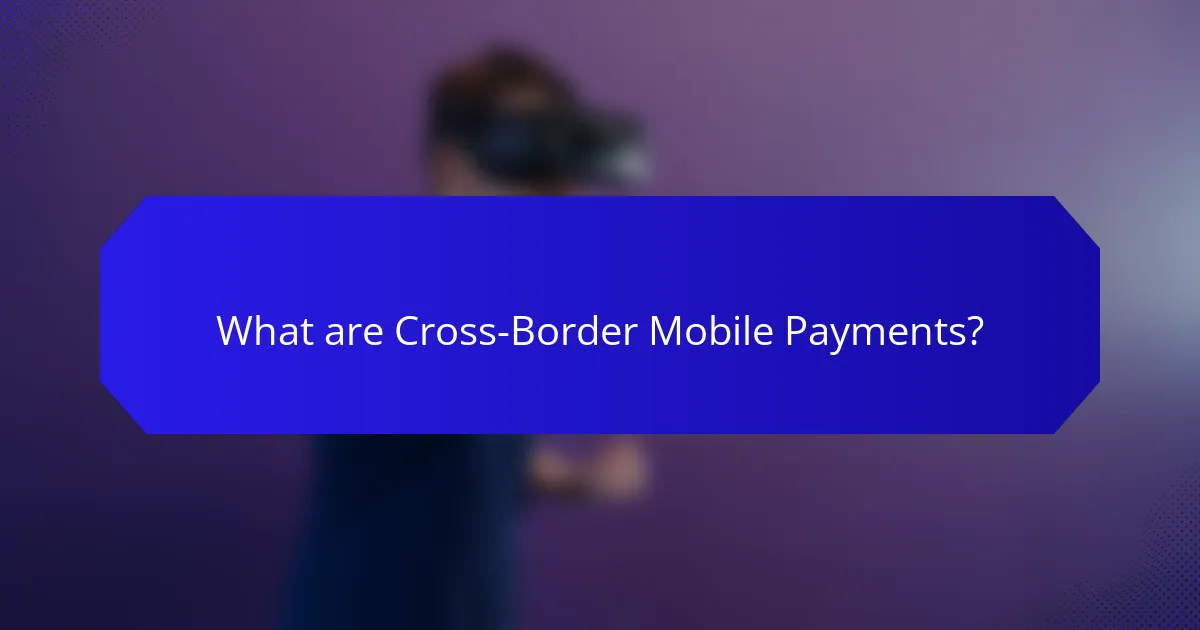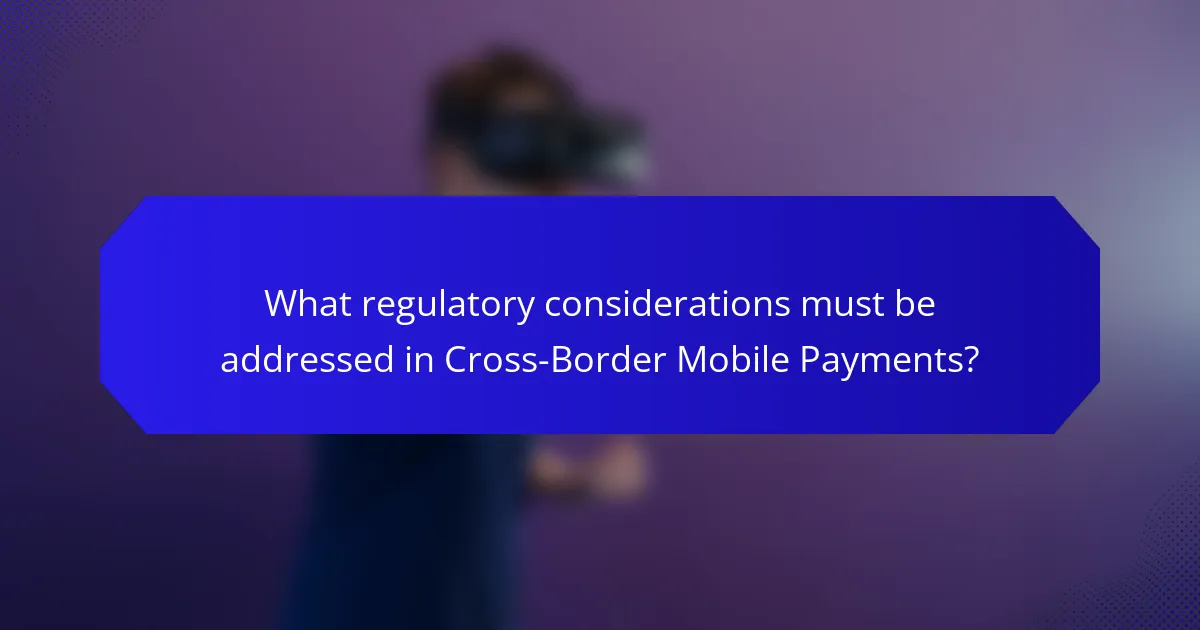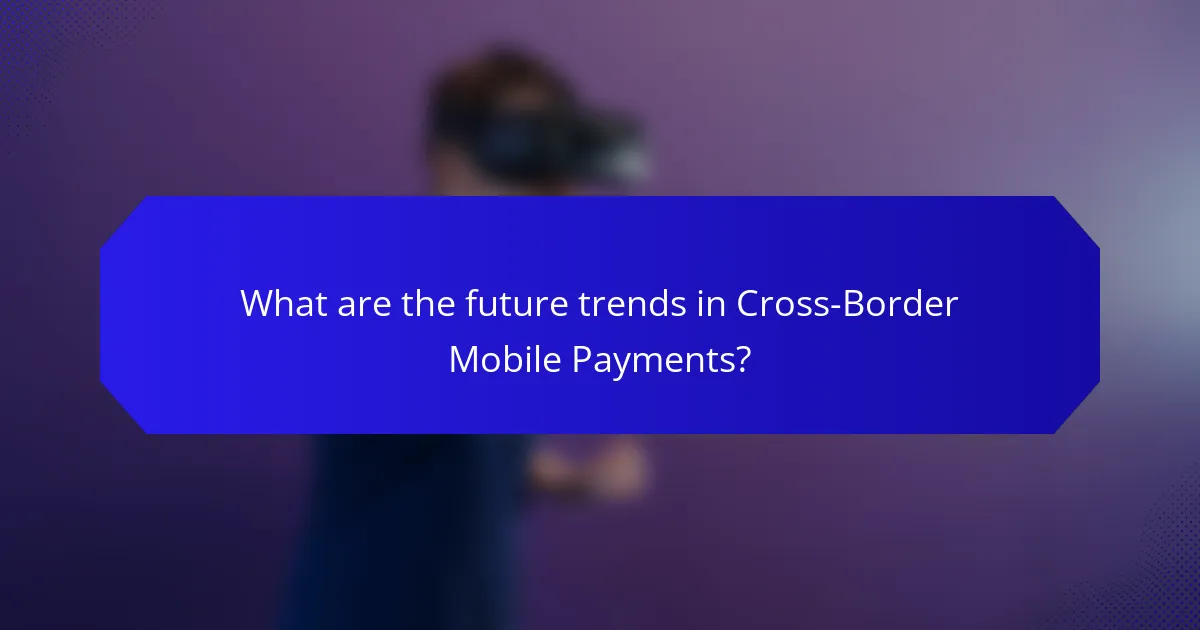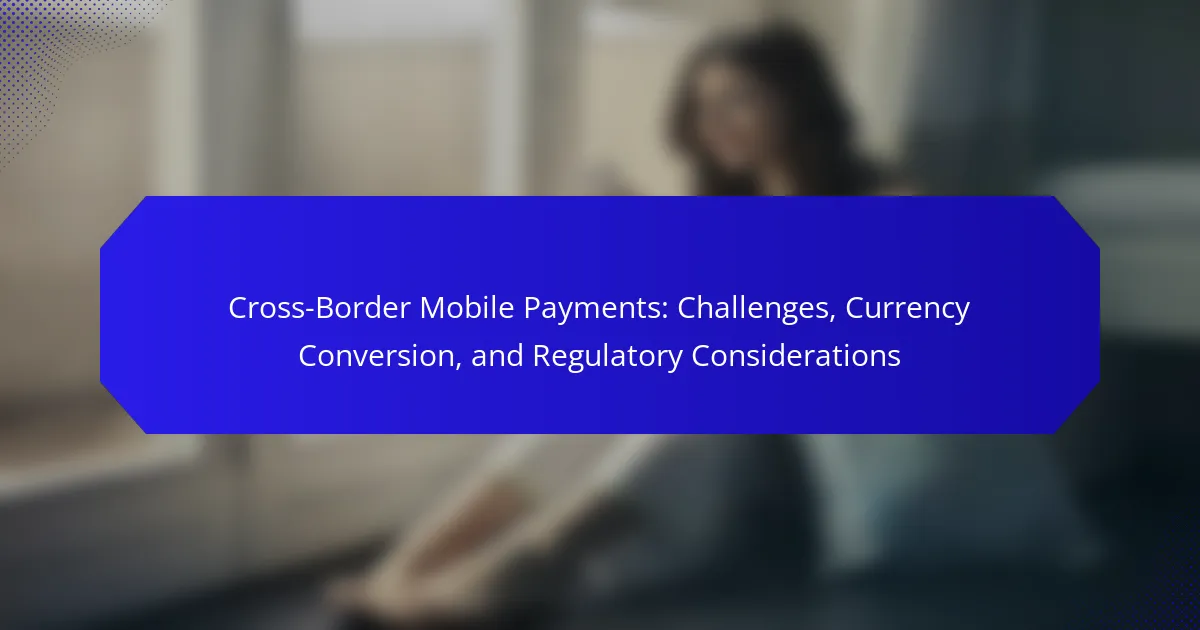Cross-border mobile payments refer to financial transactions made via mobile devices between individuals or entities in different countries. These transactions facilitate international money transfers through mobile applications, often involving currency conversion and associated fees. The article examines the significance of mobile payments in global remittance flows, regulatory requirements such as anti-money laundering (AML) and know your customer (KYC) laws, and the impact of data protection regulations like the General Data Protection Regulation (GDPR). It also explores future trends, including the adoption of digital currencies, blockchain technology, and the evolving landscape of partnerships between fintech companies and traditional banks, highlighting the projected growth of the cross-border payment market.

What are Cross-Border Mobile Payments?
Cross-border mobile payments are financial transactions conducted through mobile devices between parties in different countries. These payments enable users to send and receive money internationally using mobile applications or platforms. Cross-border mobile payments often involve currency conversion and may incur fees related to foreign exchange rates. According to a report by the World Bank, global remittance flows reached $702 billion in 2020, highlighting the significance of mobile payments in international transactions. The rise of digital wallets and mobile banking has facilitated faster and more convenient cross-border payments.
How do Cross-Border Mobile Payments function?
Cross-border mobile payments function by enabling users to send and receive money across international borders using mobile devices. These payments utilize digital wallets or mobile banking apps to facilitate transactions. The process typically involves currency conversion, where the sender’s currency is exchanged for the recipient’s currency. Payment networks, such as Visa or Mastercard, often handle the transaction securely. Cross-border payments may incur fees based on the service provider and exchange rates. Compliance with regulations in both countries is essential for successful transactions. According to the World Bank, cross-border mobile payments have increased by over 50% in recent years, indicating growing adoption and functionality.
What technologies enable Cross-Border Mobile Payments?
Blockchain technology enables cross-border mobile payments. It provides a decentralized ledger for secure transactions. This technology reduces transaction costs and speeds up processing times. Mobile wallets facilitate user-friendly access to cross-border payments. They enable users to send and receive funds globally. Payment gateways connect merchants to various payment methods. These gateways support multiple currencies and ensure compliance with regulations. APIs allow integration of payment services into applications. They enhance the functionality of mobile payment systems. Together, these technologies create a robust infrastructure for cross-border mobile payments.
How do various platforms compare in facilitating these payments?
Various platforms differ significantly in facilitating cross-border mobile payments. Some platforms, like PayPal, offer extensive international reach and multiple currency support. PayPal processes transactions in over 100 currencies and operates in more than 200 markets. Other platforms, such as TransferWise (now Wise), focus on low-cost currency conversion and transparent fees. Wise uses the mid-market exchange rate, which can save users money on conversions.
In contrast, platforms like Western Union emphasize cash-based transfers, catering to regions with limited banking access. They provide services in over 200 countries but often charge higher fees. Additionally, blockchain-based platforms like Ripple offer fast transactions with lower fees, leveraging cryptocurrency for cross-border payments.
In summary, the comparison highlights differences in fees, currency support, and transaction speed among platforms. Each platform has unique strengths that cater to different user needs and geographical challenges.
What challenges are associated with Cross-Border Mobile Payments?
Cross-border mobile payments face several challenges. These include regulatory compliance, currency conversion issues, and security risks. Different countries have varying regulations that can complicate transactions. Compliance with anti-money laundering laws is often required. Currency conversion can lead to additional fees and unfavorable exchange rates. Fluctuating exchange rates may also affect transaction costs. Security risks include fraud and data breaches, which can undermine user trust. Additionally, technological infrastructure may be inadequate in some regions, limiting accessibility. These challenges can hinder the growth of cross-border mobile payment systems.
What are the major technical challenges faced?
Cross-border mobile payments face major technical challenges including security, interoperability, and scalability. Security is critical due to the risk of fraud and data breaches. Interoperability issues arise when different payment systems and platforms cannot communicate effectively. Scalability challenges occur as transaction volumes grow, requiring robust infrastructure. Additionally, currency conversion adds complexity, as real-time rates must be accurate and efficient. Regulatory compliance further complicates technical implementation, as differing laws across countries must be adhered to. These challenges hinder seamless cross-border transactions and require ongoing technological advancements to address them.
How do security concerns impact Cross-Border Mobile Payments?
Security concerns significantly impact cross-border mobile payments by increasing transaction costs and limiting user adoption. High-profile data breaches and fraud incidents create distrust among users. This distrust leads to lower transaction volumes as consumers hesitate to use mobile payment platforms. Additionally, service providers invest heavily in security measures to protect against these risks. These investments often result in higher fees for users, which can deter participation. Regulatory compliance also increases due to the need for stringent security protocols. For instance, the Financial Action Task Force (FATF) emphasizes the importance of security in cross-border transactions. As a result, service providers must navigate complex regulations, further complicating the payment process.
What role does user experience play in the challenges of these payments?
User experience significantly impacts the challenges of cross-border mobile payments. A poor user experience can lead to transaction abandonment. Users often face difficulties with navigation, which can frustrate them. Complex interfaces deter users from completing payments. Confusion over currency conversion rates adds to the challenge. If users do not understand fees, they may distrust the service. Security concerns can also hinder user confidence. Research indicates that 70% of users abandon transactions due to poor user experience. Therefore, enhancing user experience is crucial for improving transaction success in cross-border mobile payments.
How does currency conversion affect Cross-Border Mobile Payments?
Currency conversion significantly impacts cross-border mobile payments. It introduces additional fees and exchange rate fluctuations. These factors can increase the total cost of a transaction. When users convert currencies, they may face hidden charges from service providers. The exchange rate applied can differ from market rates, affecting the final amount received. According to a report by the World Bank, cross-border payment costs can exceed 7% of the transaction value. This can deter users from engaging in international transactions. Moreover, currency conversion can lead to delays in payment processing. These delays may result from the need to verify and execute conversions between different currencies.
What are the different methods of currency conversion used?
The different methods of currency conversion include bank exchanges, online currency converters, and foreign exchange brokers. Bank exchanges typically offer currency conversion services at physical branches or through online banking platforms. Online currency converters provide real-time exchange rates and allow users to convert amounts instantly. Foreign exchange brokers facilitate larger transactions and often offer competitive rates for businesses and individuals. Each method has varying fees and exchange rates, impacting the total conversion cost. For example, banks may charge higher fees compared to online converters.
How do exchange rates influence transaction costs?
Exchange rates directly affect transaction costs in cross-border payments. When the value of one currency fluctuates against another, it alters the amount received after conversion. A higher exchange rate means more local currency is needed to purchase foreign currency, increasing transaction costs. Conversely, a lower exchange rate reduces costs by requiring less local currency. According to the World Bank, transaction costs can rise by 7% or more due to unfavorable exchange rates. This variability impacts businesses and individuals making international payments. Therefore, understanding exchange rates is crucial for minimizing transaction costs in cross-border mobile payments.

What regulatory considerations must be addressed in Cross-Border Mobile Payments?
Regulatory considerations in cross-border mobile payments include compliance with anti-money laundering (AML) laws and know your customer (KYC) regulations. These regulations require financial institutions to verify the identities of their customers. They also mandate monitoring transactions for suspicious activity.
Additionally, cross-border payments must adhere to the regulations of both the sending and receiving countries. This includes understanding the tax implications and reporting requirements in each jurisdiction.
Data protection laws, such as the General Data Protection Regulation (GDPR) in Europe, also play a crucial role. These laws govern how personal data is collected, processed, and stored during transactions.
Finally, licensing requirements must be considered. Payment service providers often need specific licenses to operate in different countries. This ensures they meet the legal standards set by regulatory bodies.
How do regulations vary across different regions?
Regulations for cross-border mobile payments vary significantly across different regions. In the European Union, regulations emphasize consumer protection and anti-money laundering (AML) measures. The EU’s Payment Services Directive 2 (PSD2) mandates strong customer authentication. In contrast, the United States has a more fragmented regulatory landscape, with different states implementing varying laws. For instance, California has specific privacy regulations affecting mobile payments. In Asia, countries like China have stringent regulations on digital payments, focusing on security and data protection. Meanwhile, regions in Africa may have less formalized regulations, leading to innovative but unregulated payment solutions. These regional differences impact how mobile payment services operate and comply with local laws.
What are the key regulations impacting Cross-Border Mobile Payments in the EU?
The key regulations impacting cross-border mobile payments in the EU include the Payment Services Directive 2 (PSD2) and the General Data Protection Regulation (GDPR). PSD2 aims to enhance competition and innovation in payment services. It mandates strong customer authentication and promotes secure access to payment accounts. GDPR governs the processing of personal data, ensuring privacy and data protection for users. The e-Money Directive also regulates electronic money issuance. It sets standards for consumer protection and operational requirements for e-money institutions. These regulations collectively shape the framework for cross-border mobile payments in the EU.
How do anti-money laundering laws affect these transactions?
Anti-money laundering (AML) laws significantly impact cross-border mobile payment transactions. These regulations require financial institutions to implement strict customer verification processes. Institutions must conduct due diligence to identify and verify the identity of their customers. This process often includes monitoring transactions for suspicious activities. Non-compliance can lead to severe penalties, including fines and loss of operating licenses. AML laws also necessitate reporting large or unusual transactions to authorities. This ensures that illicit activities are tracked and prevented. Overall, these laws create a framework that enhances the security and integrity of cross-border mobile payments.
What compliance challenges do providers face in Cross-Border Mobile Payments?
Providers face several compliance challenges in cross-border mobile payments. Regulatory frameworks vary significantly across countries. Providers must navigate different anti-money laundering (AML) and know your customer (KYC) requirements. Each jurisdiction may have unique reporting obligations. Compliance with data protection laws, such as GDPR in Europe, is also critical. Providers risk penalties for non-compliance, which can be substantial. Additionally, they must manage currency conversion regulations and associated fees. These challenges complicate the operational landscape for mobile payment providers.
How do differing compliance standards impact service delivery?
Differing compliance standards significantly impact service delivery in cross-border mobile payments. These standards dictate the regulatory framework that service providers must follow. Variations in compliance can lead to delays in transaction processing. They can also result in increased operational costs due to the need for additional compliance measures. Furthermore, inconsistent standards may hinder user experience, as customers face different requirements based on their location. For instance, stricter anti-money laundering regulations in one country can complicate transactions for users in another country with more lenient rules. This inconsistency can create confusion and reduce trust in mobile payment services. Ultimately, differing compliance standards can limit market access and hinder the growth of cross-border mobile payment solutions.
What strategies can be employed to navigate these compliance challenges?
Implementing a robust compliance framework is essential to navigate compliance challenges in cross-border mobile payments. This framework should include regular audits to ensure adherence to local regulations. Establishing partnerships with local financial institutions can provide insights into regional compliance requirements. Training staff on compliance issues is critical to maintain awareness of regulatory changes. Utilizing technology for automated compliance monitoring can streamline processes and reduce human error. Engaging legal experts in international trade can help in understanding complex regulations. Staying updated on global regulatory trends is necessary for proactive compliance management. These strategies collectively enhance the ability to manage compliance effectively in cross-border mobile payments.

What are the future trends in Cross-Border Mobile Payments?
Future trends in cross-border mobile payments include increased adoption of digital currencies and blockchain technology. These innovations enhance transaction speed and reduce costs. Integration of artificial intelligence improves fraud detection and customer service. Enhanced regulatory frameworks will promote security and compliance. Mobile wallets will gain popularity due to their convenience and accessibility. Partnerships between fintech companies and traditional banks will expand service offerings. Increased focus on user experience will drive app development. As of 2023, the global cross-border payment market is projected to reach $250 billion by 2027, highlighting its growth potential.
How is technology evolving to enhance Cross-Border Mobile Payments?
Technology is evolving to enhance cross-border mobile payments through improved blockchain solutions and advanced encryption methods. Blockchain technology increases transaction speed and reduces costs by eliminating intermediaries. It provides transparency and security, ensuring that transactions are tamper-proof. Advanced encryption methods protect sensitive user data during transactions. Mobile wallets are becoming more integrated with global payment networks. This integration facilitates seamless currency conversion and lowers transaction fees. Real-time currency exchange rates are now accessible through APIs, improving user experience. Artificial intelligence is also being utilized to detect fraud and enhance security measures. These advancements collectively streamline the cross-border payment process, making it more efficient and secure.
What innovations are on the horizon for mobile payment systems?
Innovations on the horizon for mobile payment systems include enhanced security features, such as biometric authentication. These advancements aim to reduce fraud and increase user trust. Another innovation is the integration of blockchain technology, which can streamline cross-border transactions. Blockchain enables faster processing times and lower fees compared to traditional banking systems. Artificial intelligence is also being utilized to analyze transaction data for improved user experiences. This technology can offer personalized financial services based on spending habits. Additionally, the rise of digital currencies is influencing mobile payment systems. Many companies are exploring ways to incorporate cryptocurrencies into their payment platforms. These innovations collectively aim to make mobile payments more efficient, secure, and user-friendly.
What best practices should users follow for Cross-Border Mobile Payments?
Users should follow several best practices for cross-border mobile payments. First, they should choose a reputable payment provider. Established providers often have better security measures and customer support. Second, users must be aware of the exchange rates. Understanding these rates helps avoid unexpected costs. Third, they should confirm transaction fees upfront. Fees can vary significantly between providers and countries. Fourth, users should enable two-factor authentication. This adds an extra layer of security to transactions. Fifth, they should keep software updated. Regular updates protect against security vulnerabilities. Lastly, users must be cautious of phishing scams. Always verify the authenticity of communications related to payments. These practices enhance security and transparency in cross-border mobile payments.
How can users ensure secure transactions when making Cross-Border Payments?
Users can ensure secure transactions when making cross-border payments by utilizing reputable payment platforms. These platforms often implement advanced encryption protocols to protect sensitive data. Users should also enable two-factor authentication for an added layer of security. Regularly monitoring account statements helps identify unauthorized transactions quickly. Using strong, unique passwords further protects accounts from unauthorized access. It is advisable to research and choose platforms with positive reviews and strong security features. According to a report by the World Bank, secure payment systems reduce fraud risks significantly, making them a safer choice for cross-border transactions.
What tips can help users minimize costs associated with currency conversion?
To minimize costs associated with currency conversion, users should compare exchange rates across different providers. Many financial institutions and online platforms offer varying rates. Users can also consider using multi-currency accounts, which allow holding funds in different currencies. This can reduce conversion fees when making transactions.
Additionally, users should avoid converting currency at airports, as they often charge higher rates. Timing transactions can also be beneficial; users should monitor exchange rate trends to convert when rates are favorable. Lastly, using credit cards with no foreign transaction fees can further reduce costs. These strategies collectively help users save on currency conversion expenses.
Cross-border mobile payments are financial transactions conducted through mobile devices between users in different countries, enabling international money transfers via mobile applications. This article examines the functioning of these payments, the technologies that support them, and the various platforms available, highlighting differences in fees and transaction speeds. It also addresses challenges such as regulatory compliance, currency conversion issues, and security risks, while discussing future trends and best practices for users to minimize costs and ensure secure transactions. Overall, the article provides a comprehensive overview of the complexities and considerations surrounding cross-border mobile payments.
